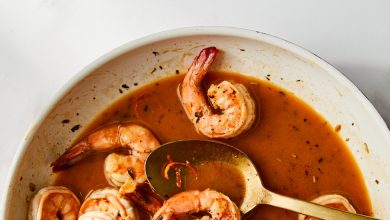How The Sims Became the Internet’s Most Exciting Place to Eat

In the last year, Kayla Sims began raising her own cows and chickens. She did a bit of traveling, trying dishes like bhel puri, tuna maki rolls, beef yakisoba and feijoada for the first time. She even did some cooking; one day, she made a crown roast and baked a birthday cake shaped like a hamburger.
But she didn’t need a farm or an airline ticket or a stove — just The Sims, the long-running video game that allows players to create characters, called Sims, and build a virtual life around them, from the houses they live in to the clothes they wear to the jobs they work.
For Ms. Sims (yes, that’s her birth name), one of the most enjoyable parts of the game has been the chance to learn more about cooking, farming, foraging and cuisines from across the world — all from the comfort of her desk in Oviedo, Fla., where she streams herself playing The Sims on YouTube and Twitch under the username lilsimsie.
“There’s just no way you could have experienced all of those things in your lifetime,” said Ms. Sims, 22. But by playing The Sims, “you learn about a lot of other foods that you’ve never seen before. And I think that everyone probably has that experience.”
Since its debut in February 2000, The Sims has become one of the most successful PC video game franchises in history, with more than $5 billion in sales as of 2019, according to its publisher, Electronic Arts. Millions of players around the world log in each day to create Sims avatars and watch their lives play out in vivid fashion. The game’s popularity has only grown throughout the pandemic; Simmers, as fans call themselves, racked up 1.2 billion hours of play in 2021.
Part of that new and, for some, renewed interest may stem from a simple need to fight off boredom. But much of the game’s appeal can be chalked up to players’ ability to create an increasingly exacting vision of how their Sims live, dress and eat.
In early versions of the game, food was used simply to satisfy Hunger, one of a handful of basic needs that every character has, or to add an element of exoticism when Sims traveled to new locales. But The Sims 4, released by the game developer Maxis in 2014, expanded the depth and realism of how players can interact with food.
“I think The Sims 4 was really where we made this conscious effort to recognize that food is more than a place,” said Lyndsay Pearson, a vice president on the creative side of The Sims, and a Maxis employee since 2002. (Electronic Arts acquired Maxis in 1997.)
Many Simmers cite the “City Living” expansion pack, a 2016 upgrade, as a major turning point for the game — it made food something to explore and learn about. Players could take their Sims to food stands, where they could not only encounter foods like pork adobo, tagine and goi cuon, but also learn to tolerate spicy foods, use chopsticks properly and, ultimately, gain the ability to make those foods at home.
Today, Sims can own and operate a restaurant or cafe, design menus and hire and fire employees. They can work their way up from assistant dishwasher (earning 15 Simoleons per hour) to celebrity chef (410 Simoleons) in the Culinary career track, or become professional food critics.
They can be vegetarian or lactose intolerant, and most Sims children go through a picky-eating phase. Sims with the Foodie personality trait, one of nearly 60 characteristics that players can choose when they create a Sim, pride themselves on eating good food, and can watch cooking shows for inspiration. They can invite friends over for a wienie roast in their backyard fire pit, order delivery from a Sims service called Zoomers, forage for rare ingredients in nearby Granite Falls or join with family members to prepare a meal.
All told, there are more than 300 dishes that Sims can try or cook across more than a dozen game upgrades.
New foods are often introduced around themes. “Sims 4: Cottage Living,” released in July, added dishes inspired by the English countryside, including bangers and mash, beef Wellington, crumpets and Yorkshire pudding. (The developers even went so far as to use “aubergine,” the British term for eggplant.)
Sims are able to can their own food; raise chickens, cows and llamas; and order groceries — though a Simple Living option allows players to cook only with what they have on hand, like produce and herbs from the garden. They cannot, however, slaughter their own livestock.
Loel Phelps, a design director for The Sims, said his team uses consultants, research and input from employees with diverse backgrounds to decide which foods, and elements of cooking and eating, best fit the spirit of the game.
“The Sims is about real, lived experiences, so once we have a theme or setting, I like to reach out to those around me or explore food trends on Instagram and TikTok,” Mr. Phelps wrote in an email. “What are their favorite iconic dishes? What do people eat for breakfast, lunch, snack and dinner in that environment? Why and how do they eat those foods, and do we have the right tools in a virtual kitchen to prepare, serve and eat them?”
Copywriters then create extensive descriptions of those foods, explaining how they’re prepared, as well as the real-world cultures where they originated. Want to learn all about pho, nigiri, choripán? The Sims can be your guide.
Since The Sims might be the first place that some players encounter these foods, it’s important that they’re provided with as accurate and precise a description of the dishes as possible, said Ms. Pearson, the Sims vice president, adding that the game developers would never describe lumpia or banh mi as “just a roll or a sandwich.”
“These mean different things,” she said. “They are made differently. And I think that it’s a way for us to also recognize that variety that exists in the world and say, ‘Yep, we see you.’”
Like reality, the world of The Sims is imperfect. Some of the foods are so pixelated that they aren’t all that appetizing. (“Some of it just looks nasty,” Ms. Sims said.) And most of the dishes that players cook most often — like spaghetti, pancakes, clam chowder and tuna casserole — still reflect a white American palate.
As a result, many players, both in the United States and abroad, don’t see their foodways reflected in the game, especially dishes that originated in South Asia or Africa.
“I’d like to see stuff I grew up eating,” said Micah Henson, 26, a doctoral candidate in applied mathematics at the University of Washington who grew up in the South, cooking alongside her mother and grandmother. “Like collard greens and baked mac and cheese and candied yams and black-eyed peas, especially like a New Year’s black-eyed-peas tradition.”
A spokeswoman for Maxis, which continues to operate as a subsidiary of Electronic Arts, said that adding new features, items and cuisines “with the goal of making all of our players of all cultures and backgrounds feel represented in the game” remains a priority. On Wednesday, for instance, dishes inspired by Brazilian Carnival and the Lunar New Year will be added to the game free of charge.
But the process is slow-going, and if there’s a food item that doesn’t exist in the game, there’s always the option to create it yourself — a practice known as “modding.” Dr. MunMun Chattopadhyay, 36, a physician in Kolkata, India, has made a name for herself by creating high-quality custom food content for The Sims.
On her website, players can download pixelated versions of shrimp and grits, cornbread, nasi lemak, rhubarb tart and fried tofu, as well as foods she grew up eating, like tandoori chicken, biryani, idli and malai kofta. Last year, Maxis officially added a few food items designed by Dr. Chattopadhyay to the game to mark its 21st anniversary.
But the doctor’s motivation for modding goes beyond a desire for formal recognition. Like most Sims players, she is seeking an escape from daily life — and satisfying her own fascination with food along the way.
“In reality, I’m just walking and walking and walking all day long, and then I have a toddler and now I’m pregnant again, so it’s very hectic,” she said. “It’s just kind of a wish fulfillment. What I cannot do in real life, I’m doing it in The Sims.”
Follow NYT Food on Twitter and NYT Cooking on Instagram, Facebook, YouTube and Pinterest. Get regular updates from NYT Cooking, with recipe suggestions, cooking tips and shopping advice.





